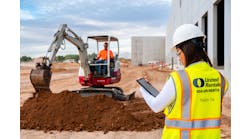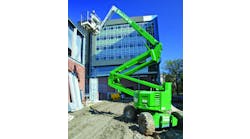It's the season for predictions. By now almost everyone in the world of business has read reams of predictions about the economy for the coming year. We pretty well know that most of the economic numbers for 2010 look a little better than 2009. The stock market is doing better. The overall economy is growing rather than contracting and there is far less panic. So supposedly we are in a recovery mode or at least bouncing along the bottom until the second half of this year when, at least in theory, things will improve.
But while what Benjamin Bernanke thinks is important — some moderate growth in 2010 compared with 2009 — we at RER decided what would be most interesting to our readers would be what people in the rental industry are predicting. And while those predictions might be less hopeful and, candidly, more depressing, at least they would pertain to the reality most of our readers are living in. So we asked rental company owners, manufacturers, service providers and economists what they expect for 2010. And here we present 30 takes on the economy for 2010. Some are more optimistic and positive than what you might expect; some are more pessimistic and negative than you want to hear. But all of it is candid and straight from the heart.
- Woody Weld, CEO, Acme Lift, Phoenix
We anticipate an increase in business during 2010 due to the slight rebound of the economy (a stop in downward movement being perceived as up), increases of spending in oil and gas production and refining, slight return of commodity and mineral business spending, healthcare facility, bridgework, governmental (military), and some other industrial and infrastructure increases (slight).
Oil is active both at the wellhead and at the refinery level. Gold, copper, coal, and other mined commodities have risen in price. Natural gas pricing is improving. We are participating in the current build of a number of healthcare projects and more are planned. Electrical power generation (including clean air updates), transmission and distribution are not where they should be but are recovering (much grid work must be completed in order to allow for new power generation to enter the grid), base closures have meant expansion on existing military bases, and infrastructure projects (specifically transportation, waste and water treatment, bridge projects, and ports) are just now receiving a small amount of governmental aid. These are the industries in which we expect business increases.
Rental companies tell us that they are quoting more than ever, that they have huge projects ready to kick off in the near future, and then when that future date arrives they tell us that the project in question didn't get funded. We expect to hear that story quite a bit in 2010, but with some improvement. Our customers say they think it will get better in 2010, that they are not going to buy much and that they have cut back as far as they could up to now.
- Ed Sullivan, chief economist and vice president economic research, Portland Cement Association, Skokie, Ill.
For residential it will probably reflect a relatively large percentage gain. That really doesn't mean anything because we're at such low levels percentages kind of disguise things. Percentage-wise, it's going to show a big increase in terms of where we're at, but most people in the construction industry are not going to see much relief.
Non-residential is expected to see dramatic declines [in 2009] followed by dramatic declines [in 2010]. That is still in contraction. On the private side, there really is no relief coming. If demand goes up, the meager gains you might see in overall construction dollars in residential will be largely offset by further declines in nonresidential.
That leaves the public sector, and that's the key. In there, the issues are a little more complex, what you've got and what everyone focuses on is the ARRA (American Recovery and Reinvestment Act of 2009), or the stimulus spending. In our industry, there is quite a bit of discussion, but they haven't seen much work come their way. Only 15 percent of that money has been spent. Paperwork delays have been one of the key problems, and those paperwork delays are gradually being overcome.
There is some momentum there, we are starting to see some money get out there, and now what you've got is the potential for some of these ARRA projects to start to materialize in the spring of next year. But the problem is that ARRA is only a portion of the public [sector], because state and local fiscal conditions will, in our mind, sterilize a large portion of those ARRA funds. Any improvement that you do see next year is probably going to be in the back half of the year.
- Dan Kaplan, Daniel Kaplan Associates, Morristown, N.J.
I'm not expecting improvement. Only the very well-managed companies will do better in 2010 than 2009. Those that have taken actions to delete or sell off underperforming assets, close underperforming branches, and cut their expenses will see a better year. For the industry as a whole, it's going to really be a year of positioning for 2011, and as in 2009, survival and liquidity is the name of the game. National companies like United Rentals are better positioned.
Rental rates will remain under pressure, but I am expecting rental rates to stabilize in 2010 versus 2009 and not see a decline like we saw in 2009 versus 2008.
Those who have industrial bases, where some revenue will be there, will probably perform somewhat better but it's going to be hard. National accounts are critical because national accounts have a stable rental base versus no revenue base at all, although national accounts require national account pricing.
I'm hopefully expecting to see somewhat of a minimal improvement in time utilization because many rental companies have taken action to cut fleet. But the key is time utilization. So in 2010 as a whole, I don't see any sectors particularly strong. There are stronger sectors like industrial but the key to success for the rental industry is nonresidential construction and I just don't see non-residential construction coming back any time before 2011, maybe 2012.
- Wes Stowers, chairman, Stowers Machinery Corp., Knoxville, Tenn.
We are forecasting our 2010 rental business to be down 20 percent from 2009. Commercial construction continues to fall in our area. Residential construction has bottomed out at a very low level, and we anticipate only modest improvement for this market in 2010. Government projects, especially those performed in-house by government agencies, will increase, but not enough to offset the overall slump in construction. I fear that construction will lag other industries as our economy begins to recover.
We made major expense reductions in 2009 that should improve our financial performance in 2010, and we made significant inventory reductions.
- Dennis Von Ruden, president, General Equipment, Owatonna, Minn.
We expect 2010 to be a flat year in both the residential and commercial construction markets. The ultimate fate of the current mortgage and default issues will drive the demand for properties. The real estate markets need to fail and then be allowed to rebound to sustainable levels. Market demand will drive the amount of construction work completed and have a direct effect upon the amount of equipment needed to satisfy these demands. We do not expect to see any appreciable increase in activity until the spring of 2011.
How many equipment rental people, and contractor supply houses will fail in 2010? We know lots are in trouble out there and I think you're going to see vendors big and large be affected by this. You can only cut back so far.
- Barry Natwick, president & CEO, Volvo Rents, Asheville, N.C.
We expect business to be flat overall in the first half of the year with gradual upturn in the second half, but nothing too optimistic. The recent comments from the Administration about turning loose some unspent stimulus funds toward infrastructure and construction may change things, but I am not too optimistic at this point. We feel the improvement in the second half of 2010 to be modest and recovery really won't get underway until the following spring.
Housing inventory still needs to be reduced before new building begins. In many areas, projects were started, land was cleared, roads were put in, and so if there are housing starts, a lot of the ground work has already been done. This may delay equipment rental demand. The real fuel to equipment rental is non-residential construction, which trails residential construction by 14 to 18 months traditionally. This would likely put most of the equipment rental demand back to 2011. Any stimulus money spent on infrastructure will have some impact but not to a significant amount.
Factors to consider are the current restrictions on lending. If recovery comes back sooner than expected or with some intensity, it is generally felt that contractors may have difficulty getting credit and may also be more conservative on capital investment, which could favor the rental industry.
- Tom Carroll, president, CS Unitec, Norwalk, Conn.
The business climate for 2010 should improve because construction equipment distributors have finally reduced their inventory and must now purchase new inventory just to supply the decreased demand. In addition, construction equipment that has been continually repaired rather than being replaced is finally wearing out and must now be replaced.
- Harry Schneider, president, Allied Financial Solutions, Florence, Ky.
Many rental companies are in a “wait and see” mode. Some are in a “hope I can endure” mode. It will take some real improvement in the economy for many of them to come out into the sunshine again.
Historically, after a recessionary time, the rental industry has experienced a boom. This recession was stronger and more widely spread. It has affected many more people than any previous recession since 1929. The rental industry will experience growth in 2010 and 2011. I don't expect a boom! People are just going to be too cautious. But, there will be an increase in business and opportunities for those rental companies who properly plan and prepare.
-
Steve Stodghill, president, Sims Crane & Equipment Co., Tampa, Fla.
We feel the amount of work will increase but the margins, due to an oversupply of equipment and the need to generate any kind of cash flow in a fiercely competitive market, will diminish returns to below cost. Low bid period is the name of the game for 95 percent of the current work going forward into 2010.
We know what we generate from our equipment rental business. We know the cost of doing that business. With the number of jobs we lose to lower bids we feel the only “turn around” will result from a reduction of current competitors by closing their doors or a local catastrophic event, such as a hurricane or worse.
- David Schmid, ECCO Equipment Corp., Santa Ana, Calif.
I expect housing to make a very small rebound by the end of the year in almost all of our markets. Our equipment should be the first to go back to work. The big unknown in California is the off-road emissions regulation. Will it be delayed? Will they add exemptions? Can it be enforced? How will contractors comply? It all affects rental in a huge way.
- Frank Bardonaro, CEO, Amquip Crane Corp., Philadelphia
We anticipate the “non tower” crane business to remain steady for 2010 compared to second half of 2009. The tower crane industry will remain in 20- to 40-percent declines in utilization and pricing for the next 24 months.
The crane rental industry is simply experiencing the same cycle we have every eight to 10 years. The same results are likely. For example, the companies who have an average fleet age of less than five years and don't have a diversified fleet of newer and “more experienced” cranes will go out of business. Consolidation will likely increase in 2010 and 2011 adding strength to the healthy companies. We intend to grow and increase geographic footprint during this cycle to be even more strategically placed in 2011 and 2012.
- Howard Hicks, vice president marketing, Holt Equipment, San Antonio
We expect highway construction to have some impact in several of our key markets during the second half of 2010. Existing home inventories continue to fall, so we expect some increase in housing starts as 2010 progresses. We are seeing a little more oilfield activity. We expect the Texas market to turn around before most other areas of the U.S. because we did not experience the excesses that some regions did and because our employment rate and other economic factors have not dipped as far as most other states. High unemployment, excess capacity in many industries, deficits in state government budgets and the significant increase in federal debt will mean a slow national recovery.
- Dave Stahlman, vice president global marketing, Doosan Infracore Portable Power, Statesville, N.C.
It's going to be a very flat first quarter and part of second quarter and then in North America we're hoping to see recovery starting in the May time frame and then growing throughout the year as things start to happen in road construction and bridge construction businesses. That should start to help us stabilize our business.
I expect the economy to rise about 5 percent above 2009 as a whole. I expect dirt-moving equipment to lag by at least six months compared to light equipment such as rammers, plates, light towers, compressors and pumps. That will lead us out just because of the built-up inertia in the channel right now in the earthmoving business. I expect lifts to lag the worst. We can talk 18 months about lifts.
I think rental companies will fare very well. They've handled the downturn well. I believe they will start turning over some of their fleet and worrying about fleet age. In our business alone we're expecting 10- to 15-percent increase in business year over year from that channel.
- Michael Kneeland, CEO, United Rentals, Greenwich, Conn.
The overall economy appears to be in the early stages of a recovery, which means that we are beginning to head in the right direction. Historically, residential construction leads the way, followed by other segments six or more months down the road. Based on that, we expect to see private non-residential construction pick up in the back half of 2010 as the recovery expands. Public non-residential work is likely to get an earlier bounce from stimulus money.
Typically, modern recessions have been followed by V-shaped recoveries, but this recession has its own characteristics that don't appear to support that pattern. Instead, we're planning on a recovery that bumps along the bottom for a while. The key to a rebound in construction is a more accommodating credit market. Construction depends on the availability of credit, and over the past year or so, the credit markets have been very tight, making it nearly impossible for contractors to line up the financing they need for projects.
- Bob Kendall, president, Star Rentals, Seattle
For those of us that supply equipment to contractors and industry the market is continuing to shrink. 2010 will undoubtedly be a rough one and in our opinion a far greater challenge than 2009. It is my strong belief that we will not see any improvement until late in 2011 at best!
Non-residential construction will continue to slip and the market is already grossly over-supplied. We expect our competitors to continue contracting in an attempt to “right size” their businesses. Most [customers] are not very optimistic about the next 18-24 months. Many companies have dramatically reduced payrolls and are operating at levels of 50 to 60 percent of where they were in 2008. It has been a huge adjustment!
- Rick Dahl, CEO, Metrolift, Sugar Grove, Ill.
Our team is projecting more of the same through the third quarter of 2010 with the hope that late 2010 and early 2011 will begin a new season in our local economy. There may be pockets of turn-around expectations with spurts of activity such as hospitals, municipality, infrastructure, some rehab and restoration work.
We can't wait for the economy to return to its former self. We must take advantage of what is given so we have changed our overall strategy and where we are going to allocate our resources. We recently rented another 30,000-square-foot building to house our wholesale and retail sales division. This aggressive approach will hopefully take advantage of the discounted used construction equipment being sold and auctioned. This major investment paid off in 2009.
Many specialty contractors' books of businesses are packed. The ones who have positioned themselves where the money is going are projecting flat and even up years in 2010.
- Craig Paylor, president, JLG Industries, McConnellsburg, Pa.
We expect the industry to grow around 20 percent in 2010, versus 2009 [in terms of] new equipment demand. In the global market, Canada is doing slightly better than the U.S., while Latin America, Asia and Australia are showing much more dynamic growth. It will likely be a slow steady climb through the second half of 2010, but still far below 2007-2008 levels. Significant growth that will approach 2007/2008 numbers will not likely appear until late in 2011 or 2012.
Among rental companies, we are likely to see more bankruptcies and/or consolidation occurring, especially in the hardest hit areas of the country and improved profit percentages for most large rental companies — compared with 2009 levels — in the second half of the year.
- Jamie Cowin, CEO, Cowin Equipment, Birmingham, Ala.
I think the second half of 2010 will see some pickup. But given how far we've fallen, a mild pickup is almost irrelevant. The fundamental problem — the 800-pound gorilla in the room — is an almost total absence of private work. There is no credit out there. Regional banks are under immense pressure to reduce the percentage of their loans outstanding from the categories of “construction” or “commercial real estate.” So even great projects with credit-worthy financing will not get funded. The banks just don't want any more loans within those silos. Until we evolve away from that, there will be a dearth of private projects and new development.
The stimulus project activity will be about two-and-a-half to three-times greater in 2010 than 2009, which is helpful; but it's not nearly robust enough to offset the lack of private construction. So, broadly speaking, it's great that the “panic” on Wall Street has passed. We are clearly past the days in which reasonable people truly feared a global economic Armageddon. But while Wall Street may be in the cure process, Main Street is still very sick. And Industrial Boulevard — where we all work — is still in an outright depression! (Construction unemployment is over 20 percent, I think that qualifies to use the “D” word.)
The vertical builders are really concerned. The grading contractors are already struggling for survival, or have lost the struggle. But there are pockets of activity including: asphalt pavers, bridge builders, industrial construction, and some energy-driven projects.
Quite frankly, many rental companies will not survive this. And I can't imagine that any will prosper. It is dangerous out there right now.
- Andrew Studdert, chairman and CEO, NES Rentals, Deerfield, Ill.
We have a proprietary data source that we have been using for the past 18 months that looks at the aerial rental business through some very sophisticated modeling, and we believe we're in the bottom of the cycle right now. We expect business to continue working at the bottom through the first half of 2010, and then start to climb gradually. I don't think it's going to be a robust outclimb but we think we'll get the combining of people eliminating fleet and the pricing disciplines plus demand, we think we'll get both a utilization and pricing uptick starting in the latter half of the year.
Customers are starting to get some business because of inventories being depleted so dramatically. We're about evenly split 50-50 industrial and non-residential construction, so the industrial guys are starting to see a pick-up off the bottom because there has got to be a minimum level of stock so we're starting to see that come back. We're getting significant business in all sectors from new manufacturing, surprisingly, we're getting business from the chip side, hospitals and boats, and shipbuilding.
- Heather Jones, construction economist, FMI Corp., Raleigh, N.C.
Nonresidential construction will decline 13 percent in 2009 and 16 percent in 2010. Nonbuilding construction will be the only positive contributor, increasing 5 percent per year in 2009 and 2010.
Single-family construction will likely recover in the second half of 2010. Starts will increase at a faster rate than put-in-place construction due to a lower dollar amount per start than over the past decade. That means that home sizes will reverse trend and become smaller.
Bright spots in nonres will be military construction (due to ARRA and BRAC funding). Steady segments will be health care and educational. Bright spots in non-building will be conservation and development. Water and wastewater will be steady and will see some large increase at least three to five years from now. Geographically the Sun Belt will remain the strongest.
A severe loosening of credit would help. We aren't expecting that until 2011.
- Daniel Leiss, president, Jenny Products, Somerset, Pa.
There is still a lot of uncertainty in many of the markets right now, and until there is some semblance of direction from those in power, we feel that companies will hesitate in any kind of major spending. We foresee a slight upturn in 2010 for rental companies, but we are looking at a broader increase in 2011.
- Walter Berry, CEO, Berry Companies, Wichita, Kan.
We are hopeful that 2010 will be flat. The Midwest went into this downturn last and I expect we will be late in coming out of it. I expect our market area to continue to be soft. I hope parts of the U.S. start to see some recovery. Our industry will be late in feeling the recovery (except maybe highway related) because there is so much “inventory” of housing and commercial buildings.
- Jim Dietz, general manager, National Lift Truck, Franklin Park, Ill.
We are expecting rental to still be slow in 2010. We are trying to reinvent our business by continuing to sell equipment on the internet. We don't see an end to the construction slowdown in Chicago. We're hoping distribution will pick up in Memphis, Tenn., and Little Rock, Ark., by 2011. We expect the food industry to stay strong, but retail will be slow, which will hurt distribution and construction. We have a very select group of customers that are saying 2010 will be better for them, but the majority are not seeing light at the end of the tunnel. As bleak as I might make it sound, we don't think it will get worse.
- Glenn Moragne, rental division manager, Halton Co., Portland, Ore.
We expect business in the second half of 2010 to be about on par with business levels in 2009. However, I expect the first half of 2010 to be below 2009 business levels, which is of concern. I would say that 2010 is another survival year and business relating to residential and commercial construction will not begin consistent and significant advances until 2011 and 2012. I expect that residential construction will make some modest improvements in 2010, compared to 2009 as well as municipal work. I believe that commercial construction relating to retail, schools and uprise housing will be weaker than 2009.
Our customers are telling us they are looking for creative ways to finance, conserve their costs, work in niches, and do anything they can to survive in 2010.
- Mike Arness, president, Clearview Financial, Ephrata, Ore.
I'm actually having banks and underwriters coming to us and asking for more business now. Delinquencies are starting to flatten out again. We were in a free-fall. In our “A” portfolios, we usually budget about a 2- or 3-percent loss. Right now we're experiencing 10-percent losses. The rental market has never been under this duress before; we're seeing more delinquencies in rental stores than I've seen in my 20 years.
Temp services around the country are starting to percolate. I'm now getting calls from temporary employment services, because that's where rehiring will begin, with temps. And then once we're comfortable, we bring them on as our own burden. Those are good signs, when you see the temps starting to perk.
- Al Kropp, CEO, Kropp Equipment, Schererville, Ind.
The next 12 months will be a repeat of 2009 with no increase in non-residential construction other than highway, which does very little for the aerial lift industry. The residential home market is the first sign of a turnaround and it is still faltering. The big box companies like Home Depot, Lowes, Costco, Wal-Mart along with big precast box and shopping-mall developers do not have any plans moving forward. I expect a continued depressed market. For 2010, road work, educational and medical facility expansions are continuing but all other non-residential construction is at a snail's pace.
We must reduce our fleet. Our utilization has been in the low 30 percent and we must be above 60 percent to be profitable. We are slowly sinking. We need a stimulus or concessions from our equipment industry. The major equipment creditors like GE, Wells Fargo, and Bank of America all have received government bailout funds. Nothing has passed to the equipment industry.
- Tom Danley, vice president of sales, Temp-Air, Burnsville, Minn.
We expect some improvement, but not until the fourth quarter of 2010. We specialize in temporary heating, cooling, dehumidifying, and air filtration rental services, and our main source of revenue has typically been construction heating in the winter. Our customers have informed us that they are beginning to bid on more construction projects for late 2010/2011 starts.
The construction industry will struggle for a majority of 2010. One of the major issues has been securing financing for new projects. Many of our customers have prepared for a tough 2010, but are starting to look forward as they are bidding on construction projects for late 2010/2011 starts.
- Ken de Vries, All-Star Rents, Fairfield, Conn.
I am worried that our business will continue to see a decline in revenue as it did in 2009. I would be thrilled if revenues leveled off and stopped sliding. California will be rough. The financial impacts of the California Air Resources Board add a double whammy.
- Linda Mayer, vice president global marketing and product management, Terex Aerial Work Platforms, Redmond, Wash.
We feel that 2010 will be slightly better than 2009. It looks like we are in the trough and by the end of 2010 we expect to see some improvement. The economy as a whole has a long way to go to dig out of the recession. Two key issues are still the need for job creation and availability of credit. The general feeling is that the recession is over, yet unemployment is still too high, consumer spending is down, housing starts are still low and credit is tight. We are beginning to see positive signs, but there is no real engine for growth yet.
The construction sector generally lags the consumer sector, so 2010 is unlikely to see significant growth. Many companies are still struggling to manage cash and manage working capital. The latest results of the Architectural Billings Index, a leading indicator, indicated a continued decline in billings. Based on the latest data, it will be at least a year before we see growth in the construction sector.
The market is still trying to find the right level of equipment equilibrium to drive time utilization and increase rental rates.
- Hastings Puckett, CEO, Puckett Machinery, Richland, Miss.
I expect business to be very challenging for the rental business, even more so than 2009. While 2009 was a very down year in the rental industry, it would have been worse if it were not for the carryover of work/projects from 2008. For 2010 I think there will be much less carryover work/projects compared to 2009 and very few new projects started. We expect a continued imbalance with the supply of rental equipment and demand for it. I have no reason to expect any meaningful turn around prior to 2011. There may be a slight improvement in business during the latter portion of the year. I expect a weak economy in our market areas and in the overall U.S.





